Hi,
I use PyTorch’s automatic gradient function to compute the Jacobian and supply it to IPOPT to solve an NLP problem.
Now I want to take the Jacobian of the following equation:
def eval_g(x):
""" The system of non-linear equilibrium conditions
x[0]: Capital stock in the next period
"""
assert len(x) == nvar
# Consumption today
con = a * k**alpha * ls**(1-alpha) - x[0]
# Labor supply tomorrow
# ls_plus = np.empty(x5.shape)
ls_plus = torch.empty(x5.shape)
for aplus_idx, aplus_val in enumerate(aplus):
ls_plus[aplus_idx] = ls_compute(
k=x[0], A=aplus_val, alpha=alpha, psi=psi, theta=theta)
# Capital stock tomorrow
k_plusplus = torch.empty(aplus.shape)
for aplus_idx, aplus_val in enumerate(aplus):
state_plus = torch.tensor([x[0], aplus_val])[None, :].float()
observed_pred = likelihood(gp_kplus(state_plus))
# k_plusplus[aplus_idx] = observed_pred.mean
k_plusplus[aplus_idx] = torch.tensor(k)
# Consumption tomorrow
con_plus = aplus * x[0]**alpha * ls_plus**(1-alpha) - k_plusplus
# ------------------------------------------------------------------- #
# Euler equation
# ------------------------------------------------------------------- #
g0 = 1 / con - beta * alpha * torch.sum(omega5 * (
1 / con_plus * aplus * x[0]**(alpha-1) * ls_plus**(1-alpha)))
return np.array([g0])
Note that the equation that I want to compute the Jacobian is g0.
Then I compute the Jacobian of the above function with the following syntax:
def eval_jac_g(x, flag):
""" Numerical approximation of the Jacobian of the system of
non-linear equilibrium conditions
Jacobian is computed by the automatic gradient of PyTorch """
assert len(x) == nvar
"""
Big skip
"""
else:
# Automatic gradient by PyTorch
assert len(x) == nvar
_eval_jac_g = np.empty(nnzj)
for i in range(ncon):
x_tensor = torch.tensor(x, requires_grad=True)
eval_g_tensor = eval_g(x_tensor)[i]
grads = torch.autograd.grad(eval_g_tensor, x_tensor, create_graph=True)
for j in range(nvar):
_eval_jac_g[j + i*nvar] =grads[0][j].detach().numpy()
return _eval_jac_g
In my previous projects, I can compute the correct Jacobian, but without success in this time.
When I remove the items started from torch.sum(), it returns the correct Jacobian; therefore, I strongly suspect that I did something wrong in torch.sum().
How should I modify the code with torch.sum() to compute the correct Jacobian?
Any comments are highly appreciated.
Thank you in advance.
Takafumi


